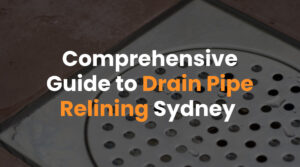Facing a blocked sewage drain can be one of the most daunting plumbing problems for any homeowner in Sydney, and there’s no doubt that addressing it promptly is crucial. This guide aims to navigate you through a step-by-step process to unblock a sewage drain, offering tips and tricks on how to recognise and deal with sewer blockages while also highlighting when professional help from a local Sydney plumber might be indispensable.
Recognising the Signs of a Blocked Sewage Drain
- Unpleasant Odours: Noticing a foul smell emanating from your drain means that there could be a sewage blockage, with waste build-up stuck inside the pipes, leading to unpleasant odours throughout your plumbing system.
- Slow Drainage: A slow-moving drain is often the first warning sign of a developing clog. Watch out for water taking significantly longer to drain away, which typically indicates an obstruction in the pipe.
- Gurgling Sounds: If you hear anomalous gurgling sounds when you flush the toilet or use a drain, this often signals a blockage in your sewer lines or drainage system, restricting the free flow of water.
- Water Backflow: Experiencing water backflow, particularly in lower-level drains or toilets, can signify a blocked main sewer line. Such incidents necessitate immediate attention to prevent further plumbing issues and potential health risks.
- Physical Evidence: In some instances, particularly for a drain outside, you might visually identify physical obstructions like tree root intrusions or other debris, which could disrupt the sewer system.
For major blockages or issues located deeper within the sewer pipes, utilising a CCTV camera might be needed to accurately diagnose the problem, and professional plumber intervention becomes inevitable.
Understanding the Causes Behind a Blocked Sewer Drain
Blocked sewer drains can manifest from various sources and cause notable drain problems, especially within the extensive plumbing systems found in locations like Sydney. Identifying the causes can offer insights into appropriate remedies, whether it’s a DIY drain solution or necessitating a skilled plumber’s expertise.
- Material Buildup: Accumulations of grease, hair, and other substances often congeal to form blockages that obstruct normal water flow, necessitating measures to clear blocked pathways.
- Foreign Objects: Unexpected items such as toys, sanitary products, or much toilet paper being flushed down can undeniably cause clogs in your sewage system.
- Tree Roots: Intrusive tree roots can penetrate sewer lines, creating a drain blockage and often requiring professional intervention to rectify without digging up your yard.
- Structural Issues: A misaligned pipe or breakage could disrupt the system and potentially necessitate pipe relining or other repair approaches.
- Stormwater Infiltration: Particularly in areas like Sydney, stormwater can infiltrate sewer lines, exacerbating clogged drains and complicating the ways to clear the obstruction effectively.
The Impact of Pipe Damage on Drainage
Pipe damage can cast a substantial impact on your drainage system, notably amplifying issues and making it difficult to clear a blocked drain effectively. Several aspects underscore the repercussions of such damages:
- Disrupted Flow:Damaged pipes can hinder the seamless flow of wastewater, potentially leading to instances where even after employing methods (like using a plunger or chemical drain cleaners), the drain is still blocked due to structural anomalies.
- Backups: Leaks or breaches in the pipe can cause wastewater to back up, potentially introducing contaminants into your home and demanding immediate action to dislodge the disruption.
- Environmental Impact: Pipe damage can lead to wastewater seeping into the surrounding environment, potentially contaminating stormwater systems and other natural resources.
- Property Damage:Persistent leaks or backflows from damaged pipes could inflict water damage on your property, sometimes requiring extensive repairs.
The Importance of Timely Sewage Drain Repair
Ensuring swift and effective sewage drain repair is not merely about addressing present inconveniences but safeguarding your property against subsequent, potentially severe complications. Procrastinating on essential repair works, whether it’s dealing with a minor blockage or a notable breakage, can exponentially intensify the adverse impacts on both your property and the wider environment.
Protecting Your Home from Backups
A clogged or compromised sewage drain can culminate in hazardous backups, propelling wastewater to resurface within your home. The implications of such incidents are multifold:
- Health Risks: Backups can introduce bacteria and harmful pathogens into your home, jeopardising the health and well-being of inhabitants.
- Property Damage: Persistent backups or overflows might damage flooring, walls, and valuables, necessitating potentially costly repairs or replacements.
- Decreased Property Value: Recurrent sewage issues and resultant damages could depreciate your property’s value and deter potential future buyers or tenants.
To circumvent these issues, adopting preemptive strategies such as regular maintenance and adhering to best practices regarding what can and cannot enter the sewage system is imperative.
The Environmental Impact of Neglected Sewer Issues
A neglected sewer doesn’t only impact the immediate property but extends its influence to the broader environment, particularly evident in the following areas:
- Water Contamination: A malfunctioning sewage system can leak contaminants into the natural water supply, posing threats to local ecosystems, wildlife, and potentially impacting human water sources.
- Soil Contamination: Persistent leaks or overflows might permeate the soil, disrupting local flora, and potentially introducing hazardous substances into agricultural areas.
- Greenhouse Gas Emissions: Unrestrained sewage can emit methane, a potent greenhouse gas, contributing to atmospheric changes and climate-related issues.
Tending to sewage issues promptly and efficiently, therefore, surfaces as not merely a personal necessity but an environmental responsibility. Utilising professional plumbing services for routine check-ups and adhering to sustainable waste management practices can significantly mitigate the risks and consequences of neglected sewage systems.
Basic Tools Needed to Unblock a Drain
Addressing a blocked drain, one of the most common plumbing issues, demands employing certain tools and protective gear. In various scenarios, from easy DIY fixes to more complex blockages, you’ll need to be prepared with the right instruments and knowledge to safeguard your plumbing system.
- Plunger: The initial tool often reached for, useful for trying to unclog basic blockages by creating suction and pressure.
- Drain Snake and Auger: Both the handheld drain snake and the slightly more advanced drain auger are pivotal tools for dealing with blockages slightly deeper within the pipes.
- Baking Soda and Vinegar: A tried-and-true home remedy that employs a chemical reaction to dissolve certain types of clogs, offering an alternative to caustic soda and other harsh chemical solutions.
- Rubber Gloves: To protect your hands and maintain health and safety standards while working with potentially unsanitary blockages.
- Coat Hanger: A simple, bent wire coat hanger can be utilised to remove or dislodge visible obstructions, especially in the initial part of your plumbing system.
- Hydro-Jet: For more deeply-seated blockages, Hydro-jets, which are long steel cables with a bladed tip that works like a drill, can be employed to navigate through and break apart obstructions.
- CCTV Drain Camera: In cases where the clog is elusive or challenging to locate, a camera can provide visual insight (the camera shows the exact location) into what’s stuck in the pipe and where it is.
Step-By-Step Guide to Unblocking a Sewage Drain
- Safety First: Always prioritise your health and safety. Wear rubber gloves and ensure the work area is well-ventilated, particularly if you’ll be using any chemical agents to try and unclog the drain.
- Visual Inspection: Before diving into using hot water or an auger, inspect the drain to identify any visible obstructions that might be easily removed with a coat hanger or plunger.
- Try Simple Solutions: Begin with non-invasive methods. Pour hot water down the drain, or employ a baking soda and vinegar solution, allowing it to work on the blockage for several minutes before flushing it out with more hot water.
- Use Basic Tools: If the blockage persists, try using a drain snake or auger to manually dislodge the clog, rotating it in a clockwise direction to help break through the obstruction.
- Employ a Plunger: For persistent clogs, use a plunger, ensuring a firm seal and applying forceful, steady plunges to potentially move the blockage.
- Jetter for Tough Clogs: In worst cases where blockages remain steadfast, using a jetter may be necessary to apply focused force on the obstruction, breaking it down.
- Professional Insight: If at this stage, the blockage still persists, it’s advisable to contact a professional, such as Plumbwell Plumbing Service, especially if you reside in Sydney, to adhere to local regulations and ensure an effective, safe resolution.
- Maintenance: Once the drain is successfully unblocked, regular maintenance and employing preventative measures, like utilising drain strainers and avoiding disposing of grease down the drain, can avert future issues.
DIY Ways to Unblock Sewer Drains
Embarking on a DIY journey to unblock sewer drains can be a pragmatic and satisfying approach, particularly when the blockage is relatively mild and can be addressed without professional assistance. Here are some accessible strategies, making use of the principle that prevention is the key and regular efforts to clean the drain can obviate more significant issues down the line:
- Boiling Water: Sometimes, a simple flush of boiling water can be enough to dissolve or dislodge blockages, especially those consisting of fats, oils, or other soluble materials.
- Manual Removal: Donning a pair of durable gloves, you might be able to manually remove any visible obstructions, such as accumulated debris or foreign objects, from the drain.
- Plumbing Snakes: A plumbing snake can be fed into the drain until it reaches the blockage, then turned and maneuvered to break apart or retrieve the obstructive material.
- Jetters: For more tenacious blockages, jetters, which are long, flexible hoses that dispense high-pressure water, can be deployed to forcefully disrupt and displace blockages within the sewer drain.
- Homemade Solutions: Combinations like baking soda and vinegar, followed by hot water, can also act to gently break down clogs without damaging the pipes.
Employing these DIY methods judiciously can safeguard your sewer drains, maintaining their functionality and mitigating the risk of major blockages. Always proceed with caution and prioritise safety in your DIY endeavours.
Tackling a Blocked Drain Outside the House
Addressing a blocked drain situated outside the house often necessitates a somewhat different approach, given that these blockages can often be more substantial and are subject to diverse contributory factors, such as external debris or tree roots.
- Physical Inspection: Begin by visually inspecting the area around the outdoor drain for any visible blockages or damage. Remove any debris or blockages that are easily accessible.
- Use of a Plunger: Apply a plunger to the drain, employing vigorous plunging action, which might dislodge minor blockages or move them to a position where they can be more easily removed.
- Employing Jetters: Utilising jetters that are long enough to navigate through the extensive pipe network outside can be particularly beneficial for dealing with robust blockages located further within the system.
- Biodegradable Solutions: For outdoor blockages, consider using biodegradable chemical agents that won’t harm the surrounding environment while working on dissolving the blockage.
- Pipe Inspection: In instances where the blockage is elusive or recurrent, utilising a drain camera to inspect the pipes can illuminate the root cause, enabling a more targeted intervention.
- Professional Assistance: If the outdoor blockage is proving particularly stubborn or is recurrent, don’t hesitate to enlist professional help to ensure that it’s addressed effectively without risking damage to the surrounding pipes or environment.
When to Seek Professional Plumbing Services in Sydney
While there’s a range of DIY methods for handling minor drain issues, certain situations signal the necessity for professional plumbing services. In a city like Sydney, where complex plumbing networks are common, recognising these moments ensures that the issues are addressed proficiently, safeguarding against potential secondary problems:
- Persistent Blockages: When using conventional methods like plungers, drain snakes, or homemade solutions fails to unblock the drain, professional intervention becomes imperative.
- Recurrent Issues: If you’re repeatedly encountering blockages or other plumbing problems, it suggests an underlying issue that warrants a professional assessment.
- Water Backflow: Experiencing backflow, where wastewater returns through the pipes into your home or property, indicates a serious issue that requires urgent professional attention.
- Signs of Damage: Observing signs of damage, such as leaks, water stains, or unusual noises within your plumbing system, signals the need for a professional evaluation.
- System Installation or Repair: For the installation of new plumbing systems, alterations, or significant repairs, employing a professional plumber ensures compliance with Sydney’s regulatory standards.
- Invasive Procedures: Situations requiring wall, floor, or pipe penetrations to access or repair the plumbing network should always be handled by professionals to avoid structural damage or further issues.
Advanced Techniques for Unclogging Sewage Drains
Navigating through a severely clogged sewage drain can necessitate deploying advanced techniques, melding DIY savvy with specialised know-how:
- Hydro-Jetting: This involves utilising a high-pressure hose system to forcefully expel blockages and build-ups from within the pipes. Though specialised equipment is required, it’s a non-invasive and highly effective method.
- Electromechanical Cleaning: Also known as drain snaking, this involves using an electrically powered device to cut through or dislodge blockages, proving particularly effective for roots or hard obstructions.
- CCTV Drain Camera Inspection: Utilising a specialised camera to visually explore and diagnose internal pipe issues, allowing for targeted interventions and mitigating unnecessary explorative procedures.
Employing Chemical Solutions Safely
Using chemical solutions to unblock drains can be effective but warrants careful handling to ensure safety and environmental responsibility:
- Choose Environmentally Friendly Options: Opt for biodegradable and eco-friendly chemical solutions that are effective yet minimise the environmental impact.
- Use Protective Gear: Always utilise protective gear, such as gloves and goggles, to safeguard against accidental spills or splashes.
- Follow Instructions Diligently: Adhere to the usage instructions provided on the packaging, ensuring accurate dosage and safe utilisation.
- Ventilation:Ensure that the work area is well-ventilated, minimising inhalation of potentially harmful fumes.
- Dispose of Containers Responsibly: Post-use, ensure that containers are disposed of responsibly, adhering to local waste management guidelines.
- Avoid Mixing Chemicals: Never mix different chemical solutions, as this can precipitate dangerous reactions.
- Responsible Use: Be cognizant of the potential impacts on your pipes and the wider environment, using chemical solutions judiciously and as a last resort.
Preventative Measures to Avoid a Blocked Drain Pipe
Blocked drain pipes can be inconvenient, disruptive, and, at times, costly to resolve. Employing a series of preventative measures not only mitigates these issues but also prolongs the durability and functionality of your plumbing systems:
- Regular Cleanings: Perform routine cleanings of your drains to eliminate accumulating debris using hot water, vinegar, or biodegradable solutions.
- Installing Drain Guards: Utilise drain guards to prevent solid waste, such as food particles, hair, and other debris, from entering your drain pipes.
- Mindful Disposal: Be conscious about what goes down your drain. Avoid disposing of fats, oils, or grease down the drain, and be cautious about the objects that may accidentally slip through.
- Tree Root Management: Ensure that trees, particularly those with invasive root systems, are planted a safe distance from your drain pipes to mitigate against root intrusion.
- Regular Inspections: Periodically inspect your drains and pipes for signs of wear, damage, or impending blockages, allowing for preemptive intervention before issues escalate.
- Avoid Chemical Cleaners: Limit the use of harsh chemical cleaners, which can corrode pipes over time, opting instead for gentler, environmentally friendly options.
- Educate Inhabitants: Ensure that all inhabitants of your property understand the importance of responsible disposal habits to safeguard against unnecessary blockages.
Need an Expert to Unblock a Sewage Drain at Your Property?
Swift and reliable assistance is just a call away with Plumbwell Plumbing Services. Dial (02) 9064 2861 now for expert solutions to your urgent plumbing predicaments, available 24/7 to serve you in any emergency.








